Below is a guide to the McDermott Nature Trail at Hoxie Gorge.
The trail is one mile long, some parts with an uphill climb. There are 38 marked stations on the trail to familiarize you with the sights and sounds of this lush nature preserve.
The trail differs considerably during each season. Your experiences in the winter will be much different, but hopefully no less enjoyable, than those in the summer.
There are many sights and sounds on the trail not listed in this guide that may spark your curiosity. More specialized field guides available in local bookstores may help answer your questions. We hope you enjoy your visit and that you will return again.
Thank you for not littering and for remaining on the trails. Although several of the species you will see are edible, for your own safety, please do not pick or eat any plants.
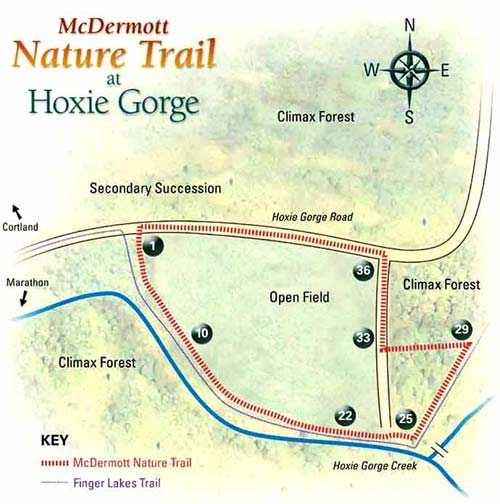
- Warbler
- Poison Hemlock
- White Ash
- Our Changing Forests
- Musclewood /Witch Hazel
- Spring Flowers
- Primary Succession
- Ferns
- Basswood
- Ironwood
- Snags
- American Beech
- Haircap Moss
- Black Cherry
- Animal Life
- Hemlock
- Quaking Aspen
- Jack-in-the-pulpit
- Sapsucker Drillings
- Monarchs and Milkweeds
- Maples
- Clubmosses
- Fungi
- The Stream Ecosystem
- Stinging Nettles
- Iroquois Medicines
- Geology of Hoxie Gorge
- Woodland Flowers
- Life of a Dead Tree
- Birches
- Climax Forest
- Interrupted and Hay-scented Ferns
- Field Wildflowers of summer and Fall
- Northern Arrowwood
- Trapping Insects Using Deceit
- The Aster Family
- Shadbush
- Butterflies
1 - Warbler
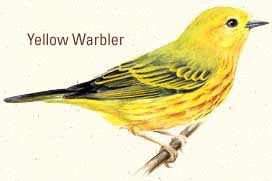 In the spring and summer, stop and listen for the clear and musical sounds of warblers. Some of the common recognizable songs you may hear are of the yellowthroat (wichety wichety wichety), the yellow warbler (a rambling song often ending with sweet sweet sweet ti ti ti to soo), and the chestnut-sided warbler (witew witew witew weechew).
In the spring and summer, stop and listen for the clear and musical sounds of warblers. Some of the common recognizable songs you may hear are of the yellowthroat (wichety wichety wichety), the yellow warbler (a rambling song often ending with sweet sweet sweet ti ti ti to soo), and the chestnut-sided warbler (witew witew witew weechew).
If you are patient enough to see the birds, you will discover that the males have brightly colored feathers during the breeding season. These small birds spend their winters in the tropics and migrate long distances over the Gulf of Mexico in the spring. A number of these neotropical migrant populations have declined in recent years as a result of habitat loss in the tropics and fragmentation of the forests in their summer breeding areas.
The open fields around the forest fragments have provided suitable habitat for the brown-headed cowbird, leading to its increased abundance. The cowbird lays its eggs in the nests of songbirds. The rapidly growing cowbird hatchlings steal food from the hosts, decreasing their reproductive success. You can recognize the male cowbird by its brown head contrasting with its black body and glossy green feathers. ⇑ Back to top
2 - Poison Hemlock (Conium maculatum)
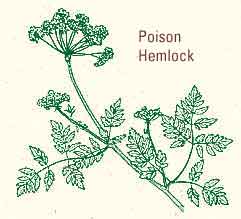 This highly toxic herb was probably the source of the poison which Socrates drank. You may notice the unpleasant, pungent smell of the plant from a distance. The many small white flowers occur in an umbel, an arrangement of flowers that resembles an umbrella.
This highly toxic herb was probably the source of the poison which Socrates drank. You may notice the unpleasant, pungent smell of the plant from a distance. The many small white flowers occur in an umbel, an arrangement of flowers that resembles an umbrella.
Poison hemlock is found in wet places. It is related to and resembles Queen Anne’s lace, a common weed of dry fields. In the winter, you can see the dead stalks standing eight-feet tall. Consumption of poison hemlock is usually fatal. Please do not touch this plant. ⇑ Back to top
3 - White Ash (Fraxinus americana)
This is one of a small number of tree species with branches that are located opposite one another. Other species include maple and arrowwood. Most trees have alternate branching. The older bark of white ash is gray and forms pointy, diamond-shaped ridges. The wood is used in making baseball bats, tool handles, and furniture.
The low-growing plant found in summer and early fall in the wet area under this ash is yellow monkey flower (Mimulus moschata). The shape of the flower resembles a grinning face. It is a relative of the snapdragon. ⇑ Back to top
4 - Our Changing Forests
The trees of a forest may change due to disease as well as succession. The spread of disease has become more common as a result of human activities. Two trees formerly found in this forest, the American elm (Ulmus americana) and American chestnut (Castanea dentata), were decimated by disease.
North America has been hit with two waves of Dutch elm disease, the second wave threatening the American elm with extinction. The disease crossed the Atlantic Ocean from northwestern Europe on shipments of logs probably several times around 1930. The disease is a fungus that is introduced into healthy trees by the elm bark beetle. As the larvae of the beetle burrow into the wood, the fungus is spread.
Chestnut blight has either eliminated or reduced most of the American chestnut trees to understory shrubs. Sprouts continue to arise from the surviving roots of the once massive, wide-spreading trees, but they rarely reach sexual maturity.
The fungus causing the disease was introduced into North America with horticultural material from eastern Asia and was first noticed in New York in 1904. Yet another fungus is currently affecting the American beech, something we’ll cover in more detail at #12. ⇑ Back to top
5 - Musclewood (Carpinus caroliniana) / Witch Hazel (Hamamalis virginiana)
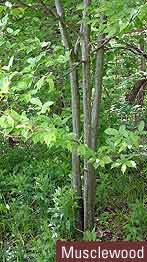 The trunk of musclewood is fluted and appears muscular. The smooth bark of this small tree is blue-gray. The elliptical leaves are doubly toothed at the edges, resembling the leaves of birch trees.
The trunk of musclewood is fluted and appears muscular. The smooth bark of this small tree is blue-gray. The elliptical leaves are doubly toothed at the edges, resembling the leaves of birch trees.
Witch hazel is an unusual shrub in that it blooms in autumn after it has dropped its large, ruffle-edged leaves. The bright yellow flowers are pollinated in late fall, and the nutlike fruits become mature a year later. The mature fruits explode, spreading the seed as far as 20 feet. ⇑ Back to top
6 - Spring Wildflowers
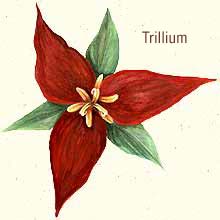 In May and June you will be rewarded with the blooms of many spring flowers along the trail. Most spring wildflowers require the moist, shaded habitat of the forest.
In May and June you will be rewarded with the blooms of many spring flowers along the trail. Most spring wildflowers require the moist, shaded habitat of the forest.
Trillium
Trillium (Trillium spp.) takes its name from the prefix “tri” meaning three. Trillium has three veined leaves and a three-petaled flower. One species has maroon flowers and is called stinking Benjamin (T. erectum). Can you discover how it got this common name? Another has white (T. grandiflorum), and a third has white with a red blaze (T. undulatum).
The flower of foamflower (Tiarella cordifolia) resembles a puff of shaving cream. Wild geranium (Geranium maculatum) has pink flowers with five petals.
The single, waxy, white flower of May apple (Podophyllum peltatum) is found at the base of the two large leaves which resemble beach umbrellas. Younger plants possess a single leaf and no flower. ⇑ Back to top
7 - Primary Succession
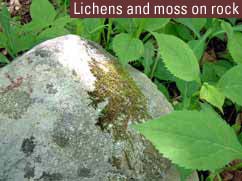 The flat gray-green organisms growing on these rocks are lichens. Lichens are a product of two different species living closely together - a fungus and an alga. Studies have shown that the fungus obtains most of the food produced by the photosynthetic algae.
The flat gray-green organisms growing on these rocks are lichens. Lichens are a product of two different species living closely together - a fungus and an alga. Studies have shown that the fungus obtains most of the food produced by the photosynthetic algae.
Lichens are pioneers of primary succession. They grow on rocks and very slowly break the rock into soil. Succession proceeds as mosses and other plants grow on the lichen-formed soil. ⇑ Back to top
8 - Ferns
 Most of the Christmas Fern plants observed so far disperse themselves by forming seeds within a fruit or within cones in the case of the hemlock tree. Along the trail you will find ferns, clubmosses, and mosses, which reproduce by germination of single cells called spores. These plants do not produce seeds.
Most of the Christmas Fern plants observed so far disperse themselves by forming seeds within a fruit or within cones in the case of the hemlock tree. Along the trail you will find ferns, clubmosses, and mosses, which reproduce by germination of single cells called spores. These plants do not produce seeds.
The underside of the lace-leaf woodfern (Dryopteris intermedia) is covered with small brown dots containing the microscopic spores. Spores are often dispersed by wind or water.
Christmas fern (Polystichum acrosticoides) grows in clumps and may be seen poking through the snow in winter. Its spores are only found on the undersides of the leaflets at the tip of the leaf. The leaflets of this evergreen fern are shaped like Christmas stockings, giving its common name. ⇑ Back to top
9 - Basswood (Tilia americana)
Interpreting nature makes use of all of your senses. Thump the trunk of the basswood tree with the palm of your hand. It will sound hollow like a watermelon. The bark is dark gray with deep furrows. The large heart-shaped leaves make identification easy in spring and summer. ⇑ Back to top
10 - Ironwood (Ostrya virginiana)
The gray-brown bark of this small tree forms vertical shaggy strips which curl away from the trunk. Like musclewood, the leaves are elliptical and doubly serrate. The zigzag twigs have sharp pointed buds. The common name is appropriate because this wood is one of the hardest and strongest known. ⇑ Back to top
11 - Snags
To a person only interested in maximum production from a woodlot, standing dead or dying trees known as snags are worthless. However, they are vitally important for a number of species, most notably the woodpeckers.
Woodpeckers from the small downy to the large pileated use snags for feeding areas, nest sites, and even territorial drumming. Woodpeckers mark their territory by drumming (pecking) on a hollow snag, the noise resonating loudly through the forest for all to hear. Recent studies in Europe have shown that overall forest biodiversity is correlated with woodpecker diversity. ⇑ Back to top
12 - American Beech (Fagus grandifolia)
American Beech
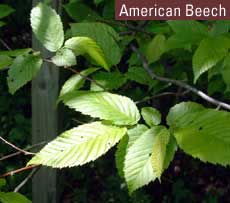
American beech is a member of the climax forest. The smooth gray bark, long pointed buds, and distinctly veined elliptical leaves are key characteristics. Some leaves remain attached to the stems even during the winter. Look for the small, spine-covered beechnuts on the ground. These are a favorite food of birds and deer.
A number of beeches in this forest are infected with beech bark disease. The disease is caused by an insect and a fungus. The insect first infests the tree and destroys cells of the living bark. This creates cracks through which the fungus can enter. The spread of the fungus kills the bark, which results in the death of the foliage and finally of the roots.
Lesions of infected trees may appear woolly white due to the insect or red due to the fungus. The continued destruction of beeches may drastically change the face of our climax forest. ⇑ Back to top
13 - Haircap Moss (Polytrichum commune)
These bristly low-growing plants require a moist habitat for at least part of the year. Separate male and female plants are necessary for this moss to complete its life cycle.
Male mosses possess a cup-shaped structure at the tip in which sperm develop. Females lack the cup; instead, they produce eggs at the tip of growth. Rain or dew transports the swimming sperm to the egg which will be fertilized within that female. The fertilized egg develops into the spore-producing structure that grows as a slender stalk and capsule attached to the female. The capsule contains hundreds of microscopic spores, which will be dispersed by the wind and will germinate into new moss plants. ⇑ Back to top
14 - Black Cherry (Prunus serotina)
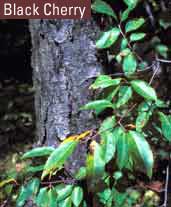 Black cherry has narrow oval leaves with finely serrated edges. The fragrant white flowers bloom in the spring and if pollinated will develop into black cherries. The mature trees have “burnt potato chip” bark. That is, the dark bark forms squarish flakes. Young cherry trees have smooth, dark red bark with wide horizontal lines called lenticels. Lenticels are pores in the bark for gas exchange. ⇑ Back to top
Black cherry has narrow oval leaves with finely serrated edges. The fragrant white flowers bloom in the spring and if pollinated will develop into black cherries. The mature trees have “burnt potato chip” bark. That is, the dark bark forms squarish flakes. Young cherry trees have smooth, dark red bark with wide horizontal lines called lenticels. Lenticels are pores in the bark for gas exchange. ⇑ Back to top
15 - Animal Life
Common inhabitants of these woods are white-tail deer, cotton-tail rabbit, eastern chipmunk, and gray squirrel. Watch for their tracks. Do you find any others?
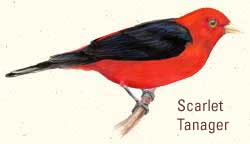 Scarlet Tanager Several species of birds may be found near here. Listen for the “chick-a-dee dee-dee” and “fee-bee” sounds of the black-capped chickadee, the eastern towhee which says “drink your teeeeee,” and the nasal “yank yank” of the white-breasted nuthatch. The scarlet tanager is a resident of mature woods, where it and other neotropical migrants control the insect numbers by feeding on them. ⇑ Back to top
Scarlet Tanager Several species of birds may be found near here. Listen for the “chick-a-dee dee-dee” and “fee-bee” sounds of the black-capped chickadee, the eastern towhee which says “drink your teeeeee,” and the nasal “yank yank” of the white-breasted nuthatch. The scarlet tanager is a resident of mature woods, where it and other neotropical migrants control the insect numbers by feeding on them. ⇑ Back to top
16 - Hemlock (Tsuga canadensis)
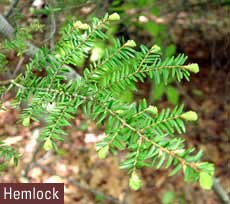 Hemlock is an evergreen member of the climax forest. The flat green needles have two white lines of stomata on the underside. Stomata are openings on the leaf through which gas is exchanged. Carbon dioxide enters the leaf and oxygen exits during photosynthesis, the food-making process in green plants.
Hemlock is an evergreen member of the climax forest. The flat green needles have two white lines of stomata on the underside. Stomata are openings on the leaf through which gas is exchanged. Carbon dioxide enters the leaf and oxygen exits during photosynthesis, the food-making process in green plants.
The needle-type of leaf has a small surface area which reduces the volume of water lost through the stomata, an important consideration during the winter drought when water is in the form of ice and snow. Deciduous trees, such as beech and oak, have broad leaves with a great number of stomata underneath. Deciduous trees must drop their leaves in order to retain water in the winter.
17 - Quaking Aspen (Populus tremuloides)
On the left side of the trail is a stand of quaking aspen (Populus tremuloides), identified by the greenish or cream-colored bark. The tree takes its name from the almost circular leaves attached to twigs by flattened leaf stems called petioles. The foliage trembles in the slightest breeze.
Quaking aspen spreads quickly by root suckering. All the aspen trunks in this stand are likely the same individual, having started from one seed. Aspen is a pioneer tree in the secondary succession of open areas.
On the gorge side of the trail is the climax forest. Which climax trees can you identify? ⇑ Back to top
18 - Jack-in-the-pulpit (Arisaema triphyllum)
Jack-in-the-pulpit may be found along the trail in moist areas. The male plant consists of a single three-part leaf and a flower contained on a club-shaped spadix (Jack) within a green or purple hooded covering called the spathe (the pulpit). Female plants have two three-part leaves. These plants can switch sex throughout their lives. In the summer, the pollinated flowers develop into clusters of scarlet berries that are eaten by squirrels. ⇑ Back to top
19 - Sapsucker Drillings
Trout Lily
Along the trail you may see horizontal lines of holes in trees such as basswood. These are the drillings of the yellow-bellied sapsucker, a member of the woodpecker family. These holes will fill with sweet sap which attracts insects. The sapsucker returns later to feed on the insects. Hummingbirds will drink the sap in spring before nectar-producing flowers have opened.
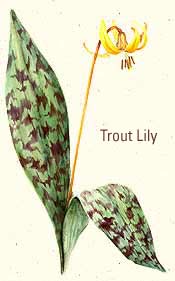 On the forest floor you may see trout lilies. Each plant will produce a single leaf during the first part of its life, then produce two leaves and a flower as it matures. ⇑ Back to top
On the forest floor you may see trout lilies. Each plant will produce a single leaf during the first part of its life, then produce two leaves and a flower as it matures. ⇑ Back to top
20 - Monarchs and Milkweeds
Secondary succession is prevented in much of the field on the left by mowing in October. An important plant that is maintained in the open field is milkweed (Asclepias spp.). Larvae of the monarch butterfly feed on its leaves, obtaining a noxious chemical which makes the species distasteful to predators.
The bright orange viceroy butterflies, which mimic the monarch’s color and pattern, have been able to survive because birds avoid them. Monarchs from this area migrate to just a dozen small sites, each about five to ten acres in size, in the Transvolcanic Mountains of Mexico.
It takes several generations to complete the annual migration from Mexico to eastern North America and back. Scientists do not know how an individual that leaves Hoxie Gorge in September can navigate its way to an isolated area in Mexico where it has never been before, but where its great-great grandparents spent the previous winter. ⇑ Back to top
21 - Maples
This large tree and the next several younger trees are sugar maples (Acer saccharum). The following small clump of trees contains red maples (Acer rubrum). Both are members of the climax population.
In red maples, the older bark near the base of the tree flakes off in rectangles. The gray bark of sugar maples forms flat ridges, like frosting on a cake, which do not flake off the tree.
Examine the twigs of each species. Notice that the buds of the red maple are blunt, while the buds of the sugar maple are sharply pointed. In both, the branches are positioned opposite on the stem. Do you recall another tree that has opposite branching?
Continue ahead and look for the patches of wild leeks (Allium tricoccum). In the spring the aroma of onions will be noticeable. The edible underground bulbs of wild leeks are used in recipes like onions. The leaves are long and narrow with parallel veins. Flowers appear in early summer in a cluster at the top of a stem. In the winter the flower remnants are still visible. ⇑ Back to top
22 - Clubmosses (Lycopodium spp.)
Carefully walk off the trail and look for low-growing, bristly evergreen plants, which resemble miniature pine and cedar trees. These are clubmosses. Like ferns, clubmosses reproduce by dispersing spores. Look for a yellow cone-like tip on some of the clubmosses. This cone is the spore-containing strobilus.
A newly germinated spore may take up to 20 years to develop into a mature spore-producing plant. Therefore, a faster method of reproduction is also necessary. Clubmosses, as well as ferns, send out runners or underground stems that connect several new plants together and allow for rapid growth.
Clubmosses, unfortunately, are collected to make Christmas wreaths. The spores, which are dispersed in yellow clouds in the fall, have been used for flash powder in photography and in fireworks.
If you wish to cut your hike short, turn left here. Follow the edge of the field uphill and continue with #33. ⇑ Back to top
23 - Fungi
 Fungi, unlike green plants, lack the photosynthetic molecule chlorophyll. Therefore, fungi get food by absorbing organic matter. Many fungi decompose dead plants and animals, returning the nutrients to the soil. Some fungi are parasites on living organisms. Do you recall diseases of trees which are caused by fungal parasites? (See #4 and #12.)
Fungi, unlike green plants, lack the photosynthetic molecule chlorophyll. Therefore, fungi get food by absorbing organic matter. Many fungi decompose dead plants and animals, returning the nutrients to the soil. Some fungi are parasites on living organisms. Do you recall diseases of trees which are caused by fungal parasites? (See #4 and #12.)
Some fungi form symbiotic associations with tree roots called mycorrhizae. The underground portion of the fungus, the mycelium, transfers the important nutrient phosphorus from the soil to the plant roots. In return, the plant provides food in the form of carbohydrates to the fungus.
Fungi disperse themselves by spreading spores which are produced on the fruiting body, the aboveground portion of the fungus. Look for the fruiting bodies of the following fungi: fly agaric (Amanita muscaria, a highly poisonous mushroom); puffballs (Lycoperdon spp.); and boletes (Boletus spp.). ⇑ Back to top
24 - The Stream Ecosystem
This stream is intimately linked to the forest that surrounds it. Its water passes through the soil and is kept cool by the shade. The leaves that fall into the stream provide the food for many aquatic organisms. The leaves are broken into particles by aquatic insects known as shredders. These particles are gathered further downstream by nets and filtering devices of other insects, the collectors. Predatory insects such as the dragonfly nymph, and fish such as the brook trout and spiny sculpin, feed on the shredders and collectors. The entire food web is changed if the forest is removed.
The trail continues on the other side of the creek. Return to the edge of the bridge and turn right. Use care in crossing the creek. ⇑ Back to top
25 - Stinging Nettles (Urtica dioica)
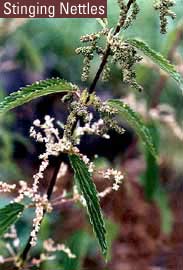 Be cautious around this tall, bristle-covered plant that grows on the creek edge. If touched, the bristles of the plant break off and a liquid is released onto your skin, producing an intense itching. The reaction usually subsides within an hour and may be relieved by applying lotion.
Be cautious around this tall, bristle-covered plant that grows on the creek edge. If touched, the bristles of the plant break off and a liquid is released onto your skin, producing an intense itching. The reaction usually subsides within an hour and may be relieved by applying lotion.
26 - Iroquois Medicines
Many of the plants along the trail were used by the Iroquois as traditional medicines. The plants with light green leaves growing in the moister areas here are jewelweed (Impatiens spp.). Jewelweeds were used for treating fevers, difficulties in urination, poison ivy and insect bites. Another common name for this plant, touch-me-not, derives from the forceful expulsion of seeds when the ripe pods are touched.
Clintonia or bluebeads (Clintonia borealis), with three long, shiny, parallel-veined leaves at the base of a flower stalk, was boiled and taken for the heart. The clustered flowers are greenish-yellow drooping bells that give rise to blue berries. The name is from New York governor DeWitt Clinton, an avid naturalist of the 1800s. ⇑ Back to top
27 - Geology of Hoxie Gorge
The geological events that shaped Hoxie Gorge as we know it today left clues of their activity in the rocks and the landscape. Continental drift theory indicates that the location of the Central New York area when the bedrock was formed about 400 million years ago was approximately the location that India occupies on the globe today.
The rocks are shales, and careful examination of layering patterns and linear grooves indicates that they were deposited as a delta. Fossils commonly found are brachiopods, organisms with a hinged shell, and sea lilies (Crinoids), sessile animals related to starfish that attached to the sediments by a stalk and filtered particulate food materials from the water with radiating arms. Circular fossils of the disk-like parts of the stalk are common.
28 - Woodland Flowers
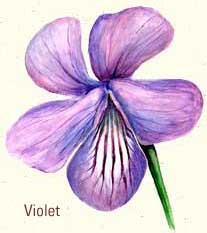 Partridgeberry (Mitchella repens) and wintergreen (Gaulteria procumbens) are low-growing evergreen plants of the forest floor. Both species produce small white flowers that develop into bright red berries. The leaves of wintergreen produce the familiar aroma and may be used to flavor tea.
Partridgeberry (Mitchella repens) and wintergreen (Gaulteria procumbens) are low-growing evergreen plants of the forest floor. Both species produce small white flowers that develop into bright red berries. The leaves of wintergreen produce the familiar aroma and may be used to flavor tea.
Violet flowers come in white, yellow, blue and violet, with several possessing a long spur. The green leaves are heart shaped. The lines on the petals of violet flowers are known as nectar guides, for they guide pollinators to the nectar at the center of the flower, facilitating cross pollination in the process.
Violets are the food plant for larvae of the fritillary butterfly. ⇑ Back to top
29 - Life of a Dead Tree
Fallen trees are common along the trail. Although these “nurse logs” are dead, they support a life of their own. Fungi are carried into the tree by burrowing bark beetles. Fungi secrete chemicals which dissolve the wood and use the products for food.
Termites and carpenter ants also consume the wood. Snails, slugs, and insect larvae live on the rotten wood and fungi. Microscopic bacteria digest the contents of the cells of the rotting tree. Larger animals, such as frogs or salamanders, find shelter and moisture here.
In the later stages of decay, the log is covered with mosses, small plants and tree seedlings. Eventually, the nutrients of the log will be recycled for use by future living organisms. ⇑ Back to top
30 - Birches
Birch is another local climax species. Yellow birch (Betula alleghaniensis) has bronze-colored bark which peels off horizontally in narrow curling strips. Known as “widow makers,” apparently healthy yellow birch trees may be dead inside and will be blown down easily.
The bark of the black birch (Betula lenta) is dark reddish brown or black and does not peel. There are wide lenticels, reminiscent of young cherry trees. Broken twigs smell and taste like wintergreen. The oil extracted from the twigs has been used to flavor the drink birch beer.
Birch leaves are oval and doubly toothed, similar to those of musclewood and ironwood. The buds of both birches grow on top of short spurs, a characteristic that distinguishes these from cherry trees. The fruits of both birch species are cone-like and grow upright from the stem. ⇑ Back to top
31 - Climax Forest
The understory trees here are primarily the seedlings and saplings of the dominant trees that form the forest canopy. This is one of the best pieces of evidence that this forest is at the climax stage of development. The climax species will reproduce themselves indefinitely until the environmental conditions change.
What factors in the environment might alter the climax forest community? Recall #4 and #12 for some examples. ⇑ Back to top
32 - Interrupted and Hay-scented Ferns
Several clumps of interrupted ferns (Osmunda claytonia) can be found here. The fronds grow up to six feet and possess regions of smaller spore-bearing leaflets, giving the frond an interrupted appearance.
Hay-scented fern (Dennstaedtia punctilobula) is a sun-tolerant species which smells like freshly cut hay. The fronds are lacy and bear spores on the undersides. Which other fern also possesses these two characteristics? (See #8.)
Return to the main trail and walk to the edge of the forest. The trail continues up the hill. ⇑ Back to top
33 - Field Wildflowers of Summer and Fall
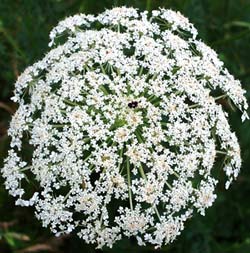 Queen Anne’s Lace or wild carrot (Daucus carota) is common to open fields. The many tiny white flowers are arranged in an umbel. The garden carrot was developed from this species. Dame’s rocket (Hesperis matronalis) is one that escaped from gardens and grows as an alien in the wild. Its pink flowers can be found commonly on the edges of woods in early summer.
Queen Anne’s Lace or wild carrot (Daucus carota) is common to open fields. The many tiny white flowers are arranged in an umbel. The garden carrot was developed from this species. Dame’s rocket (Hesperis matronalis) is one that escaped from gardens and grows as an alien in the wild. Its pink flowers can be found commonly on the edges of woods in early summer.
Butter-and-eggs (Linaria vulgaris) takes its name from the yellow and orange color of the clustered, irregularly-shaped flowers. Musk mallow (Malva moschata) grows up to two feet in height and blooms all summer. The five-petaled flowers are pink, white, or sometimes bluish and may be two inches in diameter. Do you smell the faint musk odor of the flowers? ⇑ Back to top
34 - Northern Arrowwood (Viburnum dentata)
This shrub has smooth, gray bark. The remarkably straight twigs have been used for the shafts of arrows. The opposite leaves are oval with ruffled edges. Clusters of small flowers that bloom in early spring develop into black fruit in late fall. ⇑ Back to top
35 - Trapping Insects Using Deceit
 Look for spider webs in the open field in summer and early fall. You may find some webs decorated with thread more thickly laid in the form of patterns. The thread reflects ultraviolet light which insects can easily see, and the patterns designed by the spiders resemble flowers. Pollinating insects are attracted to the web, caught, and devoured by the wily spider. Try placing a fly or small beetle on a web and observing the spider’s behavior. ⇑ Back to top
Look for spider webs in the open field in summer and early fall. You may find some webs decorated with thread more thickly laid in the form of patterns. The thread reflects ultraviolet light which insects can easily see, and the patterns designed by the spiders resemble flowers. Pollinating insects are attracted to the web, caught, and devoured by the wily spider. Try placing a fly or small beetle on a web and observing the spider’s behavior. ⇑ Back to top
36 - The Aster Family
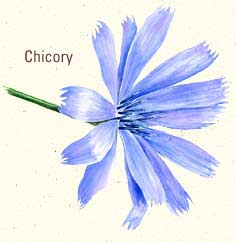 Many summer and fall wildflowers are members of the aster family. The flowers are composite; that is, there are many individual flowers on each base or receptacle. For example, each oxeye daisy (Chyrsanthemum leucanthemum) has hundreds of tiny yellow disk flowers surrounded by 20 or more white ray flowers. These are not petals, but entire flowers.
Many summer and fall wildflowers are members of the aster family. The flowers are composite; that is, there are many individual flowers on each base or receptacle. For example, each oxeye daisy (Chyrsanthemum leucanthemum) has hundreds of tiny yellow disk flowers surrounded by 20 or more white ray flowers. These are not petals, but entire flowers.
Other members of the aster family include New England aster (Aster novae angliae) with yellow disk flowers and purple ray flowers and black-eyed Susan (Rudbeckia hirta) with chocolate-colored disks and orange ray flowers. Chicory (Cicorium intybus) has only ray flowers which are light blue. The roots of chicory may be ground, roasted, and used as a coffee substitute. ⇑ Back to top
37 - Shadbush (Amelanchier canadensis)
This shrub has pale gray bark with black vertical streaks. The pointy buds are beech-like. The fruits are small, sweet-tasting red or purple berries. The berries are eaten by 27 species of birds. The birds serve to disperse the seeds when they pass the undigested seeds out of their bodies. Shadbush takes its name from the fish. The white flowers blossom in the spring at the same time as the shad run up the rivers.
Around Mother’s Day in May, the pink flowers of fringed polygala (Polygala paucifolia) can be found in abundance on the three- to six-inch plants in this area. ⇑ Back to top
38 - Butterflies
The flowers of the open field attract a multitude of butterflies. In one five-hour period in July, 32 species of butterflies were recorded in this field. Ones commonly seen include the monarch, mourning cloak, and great spangled fritillary.
The larvae of the monarch feed on milkweeds, those of the fritillary feed on violets, and those of the mourning cloak feed on willows. Which plants are the adults most attracted to for nectar? ⇑ Back to top
Trail End
There are several things to notice as you walk down the road to finish your hike. The field on the left contains goldenrod (Solidago spp.), a common species whose golden flowers mark the end of the summer. In the winter look for the remnants of goldenrod and the other field wildflowers above the snow.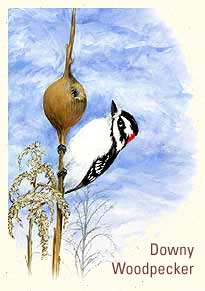 Notice the ball-shaped swelling in the stems of some goldenrods. These are called galls. Galls are formed when a particular species of fly lays its eggs in the goldenrod. As the fly larva develops, the stem tissues grow around it and form the swelling. You may note that some of the galls have holes pecked into them by downy woodpeckers, which feed on the larvae.
Notice the ball-shaped swelling in the stems of some goldenrods. These are called galls. Galls are formed when a particular species of fly lays its eggs in the goldenrod. As the fly larva develops, the stem tissues grow around it and form the swelling. You may note that some of the galls have holes pecked into them by downy woodpeckers, which feed on the larvae.
Take an unopened gall home with you. Place some soil in a large mouthed jar and insert the stem into the soil. Keep the soil moist, keep the jar away from direct sunlight, and cover with cloth. In a few months, the adult fly should emerge.
Another species of fly forms galls in willow trees (Salix spp.). Look for the swellings which resemble pine cones on the ends of the twigs of willows growing along the ditch. The larvae overwinter within these swellings and emerge in late spring as adult flies.